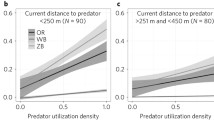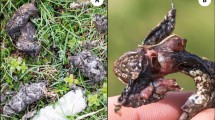Abstract
Human disturbance can be considered to have similar effects as predation risk for animals. Thus, when disturbed, animal responses are likely to follow the same economic principles used by prey when encountering predators. We simulated predator attacks with different characteristics and in different situations to study the factors that determine the escape response of 1-year-old chinstrap penguins. The results indicate that 1-year-old penguins adjusted their escape behaviour according to the level of risk posed by the researcher acting as a potential predator. When 1-year-old penguins were close to a breeding subcolony, they started to escape later, and fled shorter distances, at lower speeds, and not fleeing directly into the subcolony. This contrasts with their fleeing behaviour far from subcolonies, when penguins fled sooner, for longer, and faster, and in a direction that maximized the distance between themselves and the experimenter, by fleeing directly away from the experimenter. This might suggest the existence of a trade-off between fleeing from the predator and avoiding entering the subcolony where 1-year-old penguins will receive aggressive responses from breeding adults. The type of approach was not important in deciding when to flee. However, penguins did escape for longer distances and faster when approached directly, showing that penguins were able to assess risk level based on predator behaviour. Our findings may have implications for management of penguin colonies visited by tourists. The delimitation of buffer areas and advice on how tourists should behave when approaching penguins might arise from studies of the factors that affect risk assessment of penguins.


Similar content being viewed by others
References
Barbosa A, Moreno J, Potti J, Merino S (1997) Breeding group size, nest position and breeding success in the chinstrap penguin. Polar Biol 18:410–414
Blumstein DT (2003) Flight initiation distance in birds is dependent on intruder starting distance. J Wildl Manage 67:852–857
Blumstein DT, Anthony LL, Harcourt RG, Ross G (2003) Testing a key assumption of wildlife buffer zones: is flight initiation distance a species-specific trait? Biol Conserv 110:97–100
Bonenfant M, Kramer DL (1996) The influence of distance to burrow on flight initiation distance in the woodchuck, Marmota monax. Behav Ecol 7:299–303
Burger J, Gochfeld M (1981) Discrimination of the threat of direct versus tangential approach to the nest by incubating herring and great black-backed gulls. J Comp Physiol Psychol 95:676–684
Burger J, Gochfeld M (1990) Risk discrimination of direct versus tangential approach by basking black iguanas (Ctenosaura similis): variation as a function of human exposure. J Comp Psychol 104:388–394
Burger J, Gochfeld M (1993) The importance of the human face in risk perception by black iguanas, Ctenosaura similis. J Herpetol 27:426–430
Caraco T, Martindale S, Pulliam HR (1980) Avian flocking in the presence of a predator. Nature 285:400–401
Casaux R, Bellizia L, Baroni A (2004) The diet of the Antarctic fur seal Arctocephalus gazella at Harmony Point, South Shetland Islands: evidence of opportunistic foraging on penguins? Polar Biol 27:59–65
Cooper WE Jr (1997) Factors affecting risk and cost of escape by the broad-headed skink (Eumeces laticeps): predator speed, directness of approach, and female presence. Herpetologica 53:464–474
Cooper WE Jr, Martín J, López P (2003) Simultaneous risks and differences among individual predators affect refuge use by a lizard, Lacerta monticola. Behaviour 140:27–41
Creswell W, Hilton GM, Ruxton GD (2000) Evidence for a rule governing the avoidance of superfluous escape flights. Proc R Soc Lond B 267:733–737
De Leon A, Fargallo JA, Polo V, Potti J (2002) Adult aggression during the post-guard phase in the chinstrap penguin Pygoscelis antarctica. Polar Biol 25:355–359
Dill LM, Houtman R (1989) The influence of distance to refuge on flight initiation distance in the gray squirrel (Sciurus carolinensis). Can J Zool 67:233–235
Elgar MA (1989) Predator vigilance and group size in mammals and birds: a critical review of the empirical evidence. Biol Rev 64:13–33
Ellegren H (1996) First gene on the avian W chromosome (CHD) provides a tag for universal sexing of non-ratite birds. Proc R Soc Lond B 263:1635–1641
Enzenbacher D (1993) Antarctic tourism: an overview of the 1992/3 season activity, recent developments, and emerging issues. Polar Rec 30:105–116
Fernández-Juricic E, Jiménez MD, Lucas E (2002) Factors affecting intra- and inter-specific variations in the difference between alert distances and flight distances for birds in forested habitats. Can J Zool 80:1212–1220
Fowler GS (1999) Behavioral and hormonal responses of Magellanic penguins (Spheniscus magellanicus) to tourism and nest site visitation. Biol Conserv 90:143–149
Frid A, Dill LM (2002) Human-caused disturbance stimuli as a form of predation risk. Conserv Ecol 6:11 http://www.consecol.org/vol6/iss1/art11
Giese M (1996) Effects of human activity on Adelie penguin Pygoscelis adeliae breeding success. Biol Conserv 75:157–164
Hilton GM, Creswell W, Ruxton GD (1999) Intra-flock variation in the speed of response on attack by an avian predator. Behav Ecol 10:391–395
Kerry KR, Hempel G (1990) Antarctic ecosystems: ecological change and conservation. Springer, Berlin Heidelberg New York
Krause J, Ruxton GD (2002) Living in groups. Oxford University Press, Oxford
Lima SL (1990) Protective cover and the use of space: different strategies in finches. Oikos 58:151–158
Lima SL (1994) Collective detection of predatory attack by social foragers: fraught with ambiguity? Anim Behav 50:1097–1108
Lima SL, Dill LM (1990) Behavioral decisions made under the risk of predation: a review and prospectus. Can J Zool 68:619–640
Martín J, López P (2000) Fleeing to unsafe refuges: effects of conspicuousness and refuge safety on the escape decisions of the lizard Psammodromus algirus. Can J Zool 78:265–270
Martín J, López P (2003) Changes in the escape responses of the lizard Acanthodactylus erythrurus under persistent predatory attacks. Copeia 2003:408–413
McGarigal K, Anthony RG, Isaacs FB (1991) Interactions of humans and bald eagles on the Columbia River estuary. Wildl Monogr 115
Mínguez E, Fargallo JA, de León A, Moreno J, Moreno E (1998) Age-related variations in bill size of chinstrap penguins (Pygoscelis antarctica). Colon Waterbirds 21:66–68
Quenette PY (1990) Functions of vigilance behaviour in mammals: a review. Acta Oecol 11:801–818
Roberts G (1996) Why individual vigilance declines as group size increases? Anim Behav 51:1077–1086
Rodgers JA Jr, Smith HT (1995) Set-back distances to protect nesting bird colonies from human disturbance in Florida. Conserv Biol 9:89–99
Sokal RR, Rohlf FJ (1995) Biometry, 3rd edn. Freeman, New York
Stonehouse B (1992) Monitoring shipborne visitors in Antarctica: a preliminary field study. Polar Rec 28:213–218
Treves A (2000) Theory and method in studies of vigilance and aggregation. Anim Behav 60:711–722
Van Heezik Y, Seddon PJ (1990) Effect of human disturbance on beach groups of jackass penguins. S Afr J Wildl Res 20:89–93
Viñuela J, Amat JA, Ferrer M (1995) Nest defence of nesting chinstrap penguins (Pygoscelis antarctica) against intruders. Ethology 99:323–331
Williams TD (1995) The penguins. Oxford University Press, Oxford
Wilson RP, Culik B, Dandfeld R, Adelung D (1991) People in Antarctica - how much do Adélie penguins Pygoscelis adeliae care? Polar Biol 11:363–370
Woehler EJ, Penney RL, Creet SM, Burton HR (1994) Impacts of human visitors on breeding success and long-term population trends in Adelie penguins at Casey, Antarctica. Polar Biol 14:269–274
Ydenberg RC, Dill LM (1986) The economics of fleeing from predators. Adv Stud Behav 16:229–249
Yorio P, Boersma PD (1992) The effects of human disturbance on Magellanic penguin Spheniscus magellanicus behaviour and breeding success. Bird Conserv Int 2:161–173
Young E (1994) Skua and penguin. Cambridge University Press, Cambridge
Acknowledgements
We thank three anonymous reviewers for helpful comments. This study was based on the Spanish Army base “Gabriel de Castilla”; transport to and from Deception Island was provided by the Spanish Navy’s ship “Las Palmas”. We are grateful for the cooperation given by all participants in the Spanish Antarctic campaign 2002/2003, and especially to J.C., the “man with long sideburns”, for companionship. Financial support was provided by the Spanish Antarctic Program, MCYT project BOS 2001-3170.
Author information
Authors and Affiliations
Corresponding author
Rights and permissions
About this article
Cite this article
Martín, J., de Neve, L., Fargallo, J.A. et al. Factors affecting the escape behaviour of juvenile chinstrap penguins, Pygoscelis antarctica, in response to human disturbance. Polar Biol 27, 775–781 (2004). https://doi.org/10.1007/s00300-004-0653-x
Received:
Revised:
Accepted:
Published:
Issue Date:
DOI: https://doi.org/10.1007/s00300-004-0653-x




